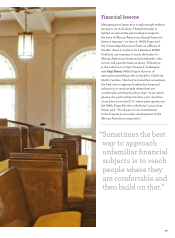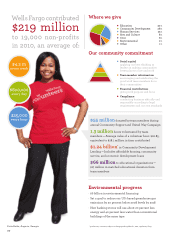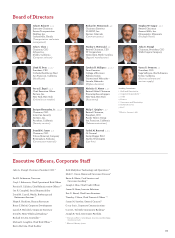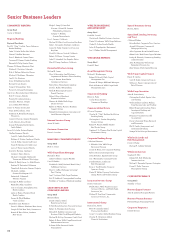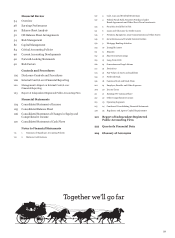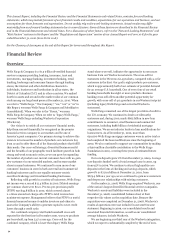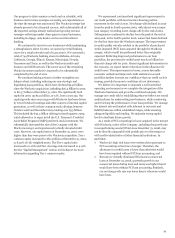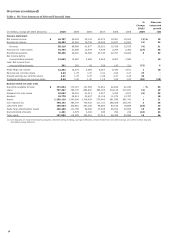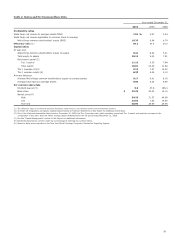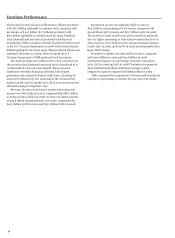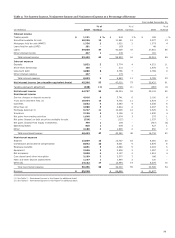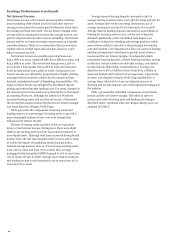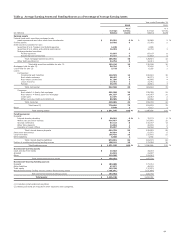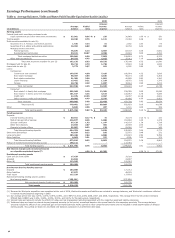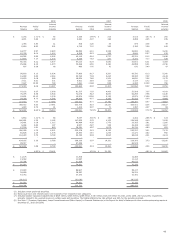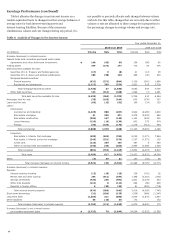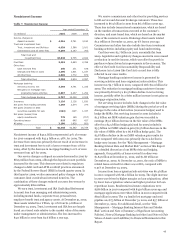Wells Fargo 2010 Annual Report Download - page 37
Download and view the complete annual report
Please find page 37 of the 2010 Wells Fargo annual report below. You can navigate through the pages in the report by either clicking on the pages listed below, or by using the keyword search tool below to find specific information within the annual report.Our progress to date remains on track and on schedule, with
business and revenue synergies exceeding our expectations at
the time the merger was announced. The Wachovia merger has
already proven to be a financial success, with substantially all of
the expected savings already realized and growing revenue
synergies reflecting market share gains in many businesses,
including mortgage, auto dealer services and investment
banking.
We continued to invest in core businesses while maintaining
a strong balance sheet. In 2010, we opened 47 retail banking
stores for a retail network total of 6,314 stores. We converted a
total of 749 Wachovia banking stores in Alabama, Arizona,
California, Georgia, Illinois, Kansas, Mississippi, Nevada,
Tennessee and Texas, as well as the Wachovia credit card
business and ATM network. The conversion of the remaining
Wachovia eastern markets is expected to be substantially
completed by the end of 2011.
We continued taking actions to further strengthen our
balance sheet, including reducing our non-strategic and
liquidating loan portfolios, which have declined $54.6 billion
since the Wachovia acquisition, including $26.3 billion in 2010,
to $115.7 billion at December 31, 2010. We significantly built
capital in 2010, up $12.9 billion, or 12%, from a year ago. Our
capital growth since our merger with Wachovia has been driven
by record retained earnings and other sources of internal capital
generation, as well as three common stock offerings between
October 2008 and December 2009 totaling over $33 billion.
This included the $12.2 billion offering in fourth quarter 2009,
which allowed us to repay in full the U.S. Treasury’s Troubled
Asset Relief Program (TARP) preferred stock investment. We
substantially increased the size of the Company with the
Wachovia merger, and experienced cyclically elevated credit
costs. However, our capital ratios at December 31, 2010, were
higher than they were prior to the Wachovia acquisition. Tier 1
common equity increased to $81.3 billion at December 31, 2010,
or 8.30% of risk-weighted assets. The Tier 1 capital ratio
increased to 11.16% and Tier 1 leverage ratio increased to 9.19%.
See the “Capital Management” section in this Report for more
information regarding Tier 1 common equity.
We experienced continued and significant improvement in
our credit portfolio, with most metrics showing positive
movement by the end of 2010. Net charge-offs declined in 2010
from the peak in fourth quarter 2009, with almost every major
loan category recording lower charge-offs by the end of 2010.
Delinquencies continued to decline from the peak at the end of
2009 and, in the fourth quarter 2010, nonaccrual loans declined
for the first time since the Wachovia merger. The improvement
in credit quality was also evident in the portfolio of purchased
credit-impaired (PCI) loans acquired through the Wachovia
merger, which overall has performed better than originally
expected. Reflecting improved performance in our loan
portfolios, the provision for credit losses was $2.0 billion less
than net charge-offs for 2010. Absent significant deterioration in
the economy, we expect future reductions in the allowance for
credit losses. The improvement in losses, a more favorable
economic outlook and improved credit statistics in several
portfolios further increase our confidence that our credit cycle is
turning, provided economic conditions do not deteriorate.
We believe it is important to maintain a well controlled
operating environment as we complete the integration of the
Wachovia businesses and grow the combined company. We
manage our credit risk by establishing what we believe are sound
credit policies for underwriting new business, while monitoring
and reviewing the performance of our loan portfolio. We manage
the interest rate and market risks inherent in our asset and
liability balances within established ranges, while ensuring
adequate liquidity and funding. We maintain strong capital
levels to facilitate future growth.
As a result of PCI accounting for loans acquired in the merger
with Wachovia, ratios of the Company, including the growth rate
in nonperforming assets (NPAs) since December 31, 2008, may
not be directly comparable with periods prior to the merger or
with credit-related ratios of other financial institutions. In
particular:
• Wachovia’s high risk loans were written down pursuant to
PCI accounting at the time of merger. Therefore, the
allowance for credit losses is lower than otherwise would
have been required without PCI loan accounting; and
• Because we virtually eliminated Wachovia’s nonaccrual
loans at December 31, 2008, quarterly growth in our
nonaccrual loans during 2010 and 2009 was higher than it
would have been without PCI loan accounting. Similarly,
our net charge-offs rate was lower than it otherwise would
have been.
35






